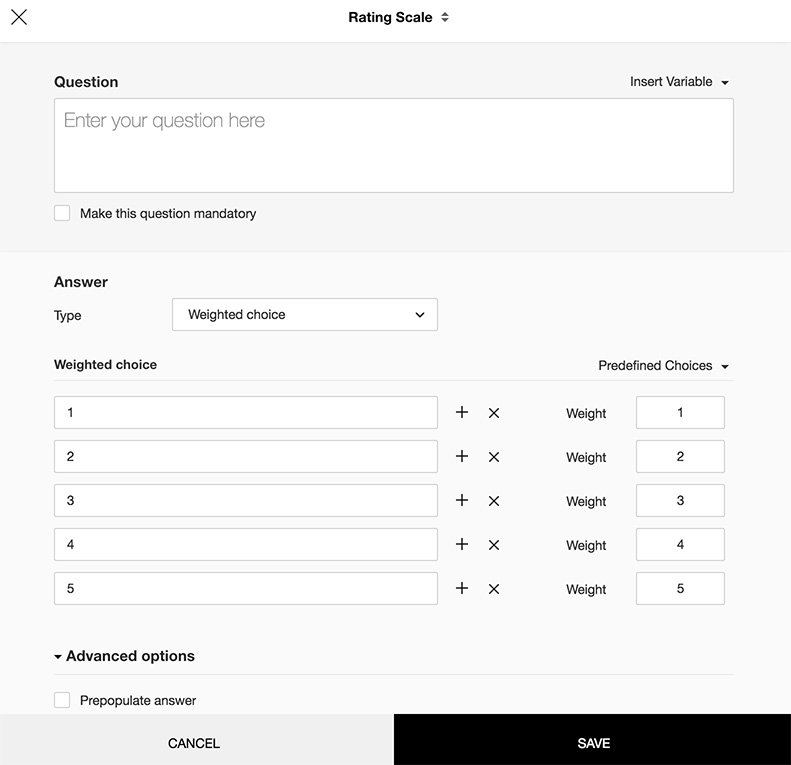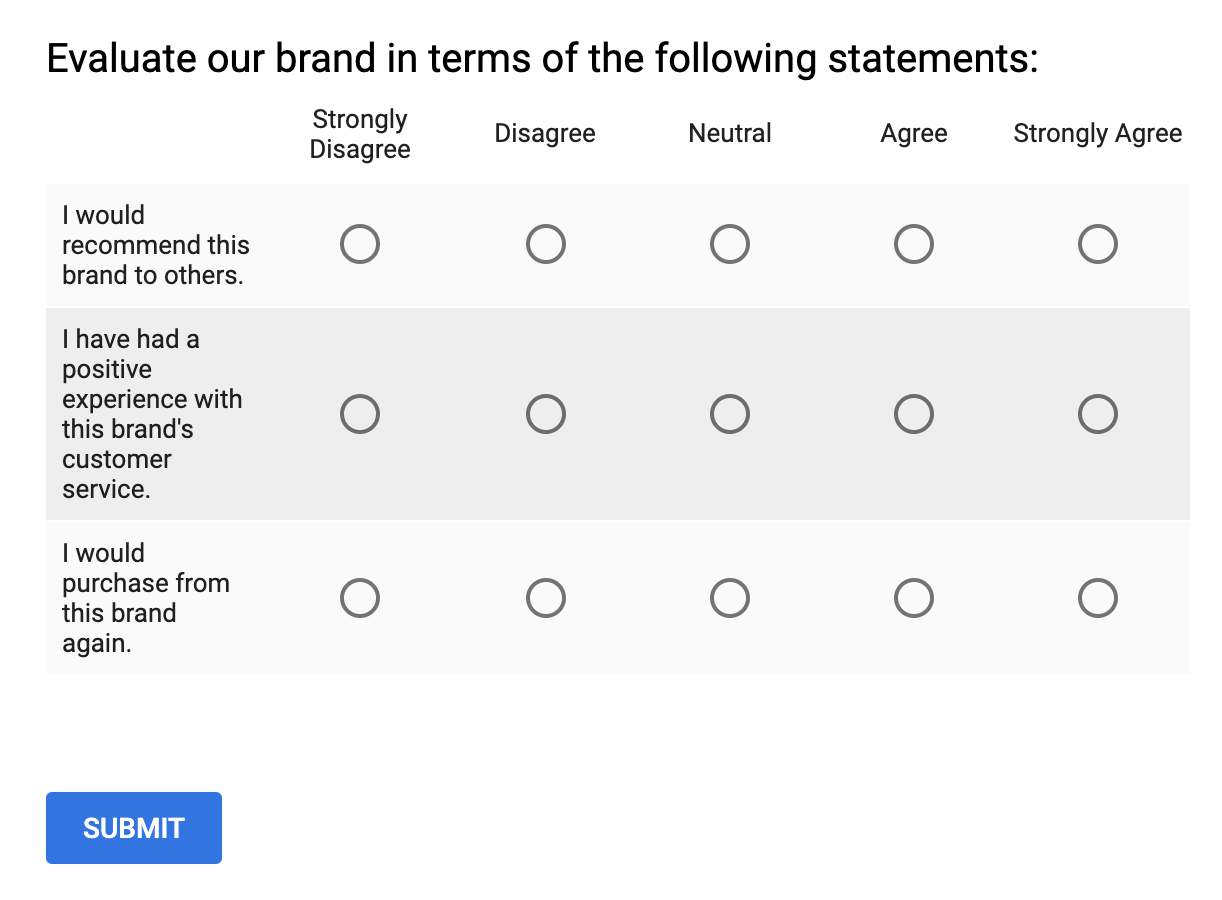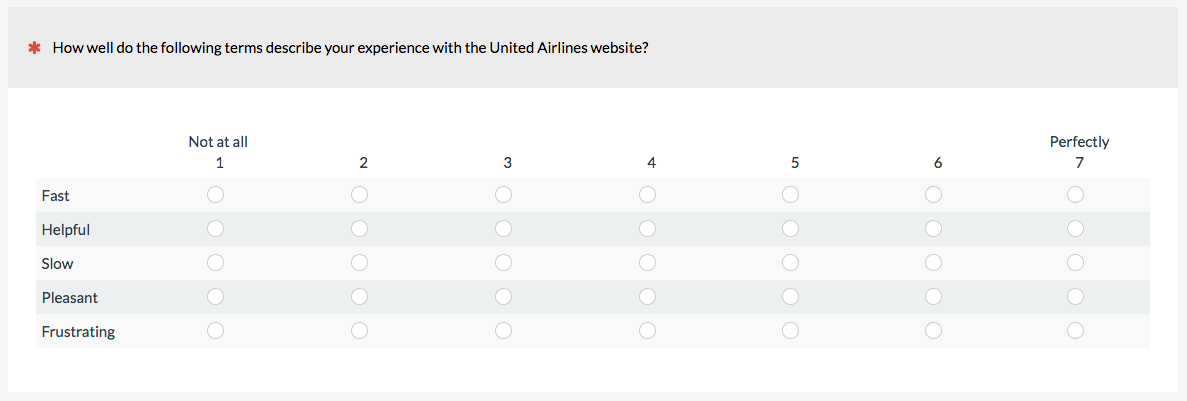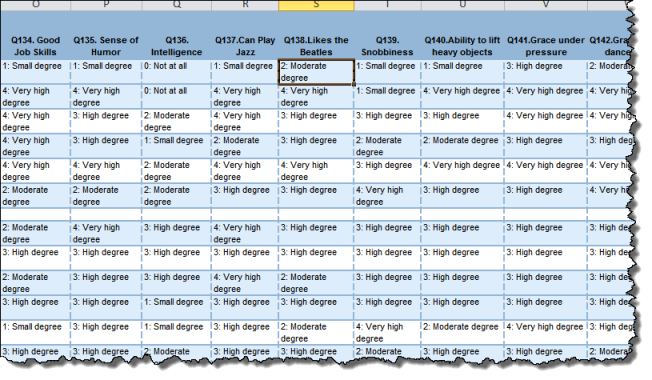38 survey rating scale labels
Survey rating scales—types and examples - SurveyMonkey Graphic scales are often used to evaluate staff performance. They're typically depicted in a table or matrix, with a list of qualities or traits down the left-hand column, and a series of rating options along the top row. The rating options can either be numbers, such as 1 to 5, or series of worded categories. Survey rating scales 1-5: Understand your audience better Businesses use survey rating scales to gather information about satisfaction levels, frequency of use, loyalty, and other customer data. Rating scales allow you to compare customer response data to determine which of your products and services are most effective. This data is essential for making informed business decisions across all departments.
Three Tips for Effectively Designing Rating Scales The most accurate surveys will have a clear and specific label that indicates exactly what each point means 5. Going back to the goals of survey rating scale points and their labels, we want all respondents to easily interpret the meaning of each scale point and for there to be no room for different interpretations between respondents.
Survey rating scale labels
What is a Survey Rating Scale? + [Types & Question Examples] A numerical rating scale is typically used to quantify qualitative data such as pain, feelings, product satisfaction, likelihood to recommend, customer loyalty and the like. Usually, the researcher labels the endpoints of the numerical rating scale in terms of the value that is being measured so that both ends represent the extremes of this value. Survey Scale: Definitions, Types + [Question Examples] A rating scale is a type of survey response scale that allows respondents to match specific qualitative values with different assertions, products, or features. With a rating scale, you simply answer the survey question by picking one of the rating options on the scale. A rating scale can be categorized as ordinal or interva l. The Use and "Abuse" of Survey Rating Scales - Verint One topic that comes up frequently is survey rating scales. While an examination of survey rating scales borders on tedious, the correct use of rating scales is critically important - and I believe that scale "abuse" is rampant. ... the case for 5-point vs. 7-point scales, rating scale labels, custom rating scales, listing negative ...
Survey rating scale labels. Rating Scale: Definition, Survey Question Types and Examples Rating Scale Definition Rating scale is defined as a closed-ended survey questionused to represent respondent feedback in a comparative form for specific particular features/products/services. It is one of the most established question types for online and offline surveys where survey respondents are expected to rate an attribute or feature. Satisfaction Surveys and Questionnaire Rating Scales 2. What measurement scale to use: Level of Satisfaction How well the product or service meets expectations How good or bad the product or service is Level of Importance 3. The number of points on the scale 4. Balanced and unbalanced scales 5. The labels for points on the scale 6. Handling "Don't Knows" 7. How to word the question in an unbiased way Should All Scale Points Be Labeled? - MeasuringU One core question about multipoint rating scales is whether to label all points or just the endpoints. ... (2007) conducted two studies that varied the style of rating scales in a web-based survey with over 5,000 U.S.-based panel respondents answering 16 seven-point items, including seven dietary habits items with endpoints of "Strongly ... Matrix/Rating Scale Question | SurveyMonkey To add this question type: Drag and drop Matrix/Rating Scale into your survey from the BUILDER section of the sidebar. In the Rows fields, enter the items you want respondents to evaluate. In the Columns fields, enter the measurements you want respondents to use to evaluate the row items. Column choices should be applicable to every row item.
Choice of rating scale labels: implication for minimizing patient ... Loading the rating scale with more positive labels appears to be a useful strategy for reducing the ceiling effect and increases the discrimination ability of survey responses. Conclusions: The current research provides a survey design strategy to minimize ceiling effects. How to Label Response Scale Points in Your Survey | Qualtrics Finally, to ensure that you get the highest-quality data possible, keep these four guidelines in mind as you practice labeling response scales: Ensure each scale point is verbally labeled; Use response options that correspond to the subject of the question; Use consistent language across the entire response scale; Use balanced scales Employee Performance Rating Scales in 2022: Examples & Definitions Overall performance ratings are given on a 5-point scale, observing employees with performances that are: 5 = Leading. 4 = Strong. 3 = Solid. 2 = Building. 1 = Not Meeting Expectations. Goals are also tracked using a 3-point rating scale that measures whether a goal or project was on time, on budget, and accomplished. 3 = Goal Was Met. Survey Response Scales - Answer Format and Types of Questions Examples: 1. Three-point Scales Good - Fair - Poor Agree - Undecided - Disagree Extremely- Moderately - Not at all Too much - About right - Too little 2. Five-point Scales (e.g. Likert Scale) Strongly Agree - Agree - Undecided / Neutral - Disagree - Strongly Disagree Always - Often - Sometimes - Seldom - Never
Your Guide to Rating Scale Questions in 2022 - Qualtrics What is a rating scale? A rating scale is a type of survey question that uses closed questions, when gaining information from a respondent. ... In practice, this means the response options for a satisfaction question your Likert scale labels should look like this: If you're dealing with an idea or construct that ranges from zero to positive ... How to Label Your 10-Point Scale - Versta Research Plenty of research shows that numeric scales going from 1 to 10 (ten points) are less effective than numeric scales going from 0 to 10 (eleven points). A recently published article in Survey Practice adds more evidence to that claim, and also suggests that the midpoint of the scale should be labeled along with the endpoints: Likert Scale: What It Is & How to Use It | SurveyMonkey To understand the Likert rating scale, you first need to understand what a survey scale is. A survey scale represents a set of answer options—either numeric or verbal—that cover a range of opinions on a topic. ... This can be tricky when using word labels instead of numbers, so make sure you know what your words mean. ... Star Rating Question | SurveyMonkey Drag and drop Star Rating into your survey from the BUILDER section of the sidebar. Enter your question text. Adjust the settings under the Edit and Options tab. Click Save. Question Settings Under the Edit tab, you can adjust the following settings specific to the Star Rating question. Colors
Survey Rating Scales to Guide Survey Respondents Effectively Every survey rating scale option is labelled with words, so the meaning is clear Every option is relevant to the question Language is consistent throughout the whole survey Use scales that balance well (have the same number of options on each side) Consider providing a "Don't know" option or "Prefer not to answer" option
Survey rating scales: numbered vs worded lists | SurveyMonkey With worded labels, the researcher has the freedom to score and label categories however they feel without confusing the respondent. Scaling can also be unbalanced, and the scoring could look something like this: Extremely Good = 10 Very Good = 8 Good = 6 Not Bad = 5 Bad = 3 The Worst = 0
Managing Survey Rating Scales (Manage Scales option) Creating a New Scale. Click the Add Scale button to create a new scale. Here you can give your scale a name - this is used when creating a rating scale on a new survey and so it should be meaningful. Next select the size of scale. Currently you can choose from 4, 5, 10 and 11 point scales. Others may be available in the future and if you have ...
Survey Response Scales: How to Choose the Right One | CXL How you design a survey or a form will affect the answers you get. This includes the language you use, the order of the questions, and, of course, the survey scale: the default values and ranges you use. Survey response scales can be embedded in the survey (e.g., 1-5, 1-10, etc.), chosen via a drop-down menu, or included as part of the survey language.
Sample Likert Scales - Marquette University 1 - Never. 2 - Rarely, in less than 10% of the chances when I could have. 3 - Occasionally, in about 30% of the. chances when I could have. 4 - Sometimes, in about 50% of the chances when I could have. 5 - Frequently, in about 70% of the. chances when I could have. 6 - Usually, in about 90% of the chances I could have.
1-to-10 Rating Scale Survey Template 🚀 Survicate Run email, link, web and mobile surveys from one tool. Create surveys in seconds with +125 profesional survey templates. Use a visual survey builder to make surveys match your brand. Make your surveys smart with skip logic, custom actions and re-directs. Get automated reports right in your inbox daily, weekly or monthly.
20 Free Ready-Made Survey Rating Scale Examples - AidaForm Multiple Rating Matrix This type of rating scale is very widely used in online surveys. It looks like a compact version of four Linear Numeric Scales put together. Please rate your attitude towards each of the brands 1 - not at all favorable, 7 - extremely favorable, N/A - I do not know the brand 1 2 3 4 5 6 7 N/A Starbucks Pizza Hut AidaForm
Which Rating Scales Should I Use? - Relevant Insights Semantic Differential Scale: A 7-point rating scale with endpoints associated with bipolar labels that have semantic meaning (e.g., bipolar adjectives like "friendly" and "unfriendly"). Variations of the Likert and Semantic Differential scales abound.
Rating scales - Google Surveys Help Google Surveys lets you choose from 5, 7, 10, or 11 stars. There has been a long-lasting debate between 5-pt vs. 7-pt and odd vs. even ( see presentation ). As our surveys are easy to copy and easy to deploy, a good practice is to run the same question with a couple alternative scales. This lets you validate and cross-tabulate the results.

Rating Scale Questions / MeasuringU: 15 Common Rating Scales Explained / Designing rating scale ...
15 Common Rating Scales Explained - MeasuringU Here are 15 scales, in roughly the order of most to least commonly used. 1. Linear Numeric Scale In a linear numeric scale, participants provide some numeric response to a question or statement. This can include things like satisfaction, ease, brand favorability, feature importance, or likelihood to recommend.
Analyzing and Interpreting Data From Rating Scales The instructions ask the students to rate on a 1 (bad) to 5 (good) scale for each of the below factors, beginning with a global rating for " Overall Satisfaction ". Our goal is to gain more insight into how students' feel about their experience throughout the curriculum. Feedback Form Questions Understanding The Rating Scale
The Use and "Abuse" of Survey Rating Scales - Verint One topic that comes up frequently is survey rating scales. While an examination of survey rating scales borders on tedious, the correct use of rating scales is critically important - and I believe that scale "abuse" is rampant. ... the case for 5-point vs. 7-point scales, rating scale labels, custom rating scales, listing negative ...
Survey Scale: Definitions, Types + [Question Examples] A rating scale is a type of survey response scale that allows respondents to match specific qualitative values with different assertions, products, or features. With a rating scale, you simply answer the survey question by picking one of the rating options on the scale. A rating scale can be categorized as ordinal or interva l.
What is a Survey Rating Scale? + [Types & Question Examples] A numerical rating scale is typically used to quantify qualitative data such as pain, feelings, product satisfaction, likelihood to recommend, customer loyalty and the like. Usually, the researcher labels the endpoints of the numerical rating scale in terms of the value that is being measured so that both ends represent the extremes of this value.











Post a Comment for "38 survey rating scale labels"